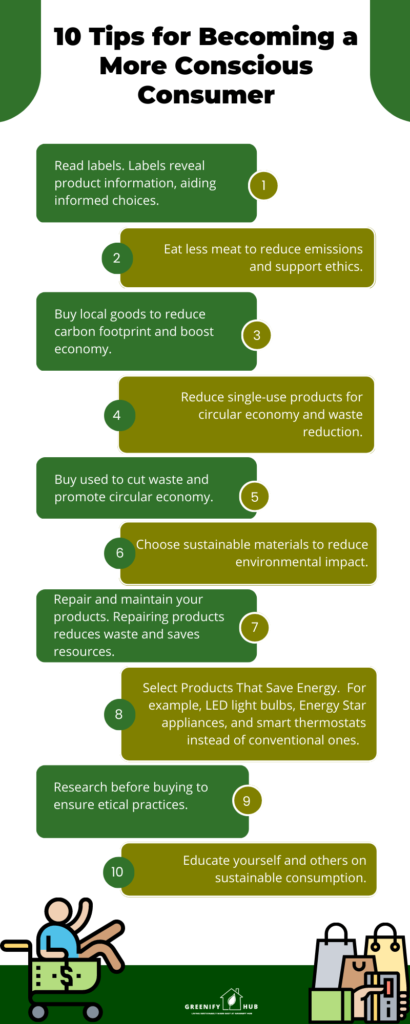15 Powerful Ways to Become a Conscious Consumer

Conscious consumerism is more than just a buzzword. It’s a powerful movement reshaping how we shop and interact with brands.
But what exactly does it mean to be a conscious consumer?
At its core, conscious consumerism is about making deliberate purchase decisions. It’s the opposite of an impulse spending splurge. Instead, it involves carefully considering the impact of our buying choices on the environment, society, and our personal values.
Imagine you’re about to buy a new pair of jeans. As a conscious consumer, you might ask yourself:
– Where were these jeans made?
– What materials were used?
– How were the workers treated?
– What’s the environmental impact of this purchase?
These questions reflect the essence of conscious consumerism. It’s about looking beyond the price tag and considering the bigger picture.
In our consumer-based industry, so-called conscious consumerism is gaining traction. More people are realizing that every purchase is a vote for the kind of world we want to live in.
Why is this important?
Because our collective buying power can drive significant change. When we choose eco-conscious purchases, we send a clear message to companies: we care about more than just the product itself.
This shift in consumer behavior is challenging industries to become more transparent and sustainable. From the fashion industry to the food sector, businesses are adapting to meet the demands of conscious consumers.
Remember, being a conscious consumer doesn’t mean never buying anything. It’s about making informed, thoughtful choices that align with your values and contribute to a better world.
Conscious consumerism involves making deliberate, informed purchase decisions that consider the broader impact on society and the environment, challenging industries to become more sustainable and transparent.
Definition and Importance
Conscious consumerism is the practice of making purchasing decisions with awareness of their wider impact. It’s about being mindful of how our choices affect the world around us.
Why is it important?
In a world of fast fashion and disposable goods, conscious consumerism acts as a counterbalance. It encourages us to think before we buy, considering factors like:
– Environmental impact
– Ethical production practices
– Product longevity
– Personal need vs. want
By adopting this approach, we can:
– Reduce waste
– Support ethical businesses
– Promote sustainable practices
– Make more meaningful purchases
It’s not about perfection, but progress. Every conscious choice counts.
Below are 15 powerful ways to become a conscious consumer:
1. Research Before Buying
2. Choose Quality Over Quantity
3. Support Ethical Brands
4. Opt for Sustainable Materials
5. Consider the Product Lifecycle
6. Embrace Minimalism
7. Educate Yourself on Industry Practices
8. Use Your Consumer Power
9. Reduce Single-Use Plastics
10. Practice Energy Conservation
11. Support Local Businesses
12. Repair and Repurpose
13. Practice Mindful Consumption
14. Advocate for Change
15. Share Your Journey

The Impact of Conscious Consumerism
Conscious consumerism is making waves across industries, especially in sectors like the fashion industry. Its impact ripples through the entire supply chain, from production to disposal.
Let’s take a closer look:
Environmental Benefits
Conscious consumers often prioritize eco-friendly products. This demand pushes companies to:
– Use sustainable materials
– Reduce water usage
– Minimize carbon footprint
For instance, some brands in the textile industry now use recycled polyester or organic cotton, significantly reducing environmental impact.
Social Impact
Conscious consumerism also shines a light on worker conditions. Consumers are asking:
– Are workers paid fair wages?
– Are working conditions safe?
This scrutiny has led to improved labor practices in many factories.
Economic Shift
As more people embrace conscious consumerism, we’re seeing a shift in market dynamics:
– Sustainable brands are growing
– Fast fashion is facing challenges
– Secondhand markets are booming
Long-term Effects
The ripple effect of conscious consumerism extends far beyond immediate purchases:
– It encourages innovation in sustainable technologies
– It promotes transparency in business practices
– It fosters a more thoughtful approach to consumption
While individual choices may seem small, collectively, they’re driving significant change in how businesses operate and how we consume.
Conscious consumerism is reshaping industries by promoting environmental sustainability, improving social conditions, and shifting economic priorities towards more ethical and sustainable practices.
Aligning Purchases with Personal Values
Aligning your purchases with your personal values is at the heart of conscious consumerism. It’s a powerful form of self-expression that goes beyond mere consumption.
Think about it:
– Do you value environmental sustainability? Choose brands that prioritize eco-friendly practices.
– Is social justice important to you? Support companies with fair labor policies.
– Do you care about animal welfare? Opt for cruelty-free products.
Each purchase becomes a statement about what matters to you.
For example, let’s say you’re passionate about reducing plastic waste. You might:
– Buy a reusable water bottle instead of disposable ones
– Choose products with minimal packaging
– Support brands that use recycled materials
This approach creates a unique combination of personal style and values. It’s not just about what you buy, but why you buy it.
Remember, every dollar spent is a vote for the world you want to live in. Make those votes count!
Aligning purchases with personal values transforms shopping into a meaningful expression of individual beliefs and priorities, making each purchase a step towards creating positive change.
The Role of Certifications in Conscious Consumerism
Certifications play a crucial role in guiding conscious consumers. They act as beacons of trust in a sea of products.
Some key certifications to look out for:
– Fair Trade: Ensures fair wages and working conditions
– Global Organic Textile Standard (GOTS): Verifies organic textile production
– B Corp: Recognizes companies balancing profit and purpose
– Forest Stewardship Council (FSC): Certifies responsibly sourced wood products
These labels help you identify products that align with your values. For instance, a certified fabric mill adheres to strict environmental and social standards.
However, remember:
– Certifications aren’t perfect
– Some companies may not afford certification despite good practices
– Always research beyond the label
Certifications are tools, not guarantees. Use them wisely in your conscious consumer journey.
Certifications serve as helpful guides for conscious consumers, providing quick insights into a product’s ethical and environmental credentials, but should be used in conjunction with further research.
Transparency in Company Practices
Transparency is the backbone of conscious consumerism. It’s about companies being open about their practices, from sourcing materials to labor conditions.
Why is transparency important?
– It builds trust with consumers
– It holds companies accountable
– It allows for informed decision-making
However, there’s often little data transparency in many industries. This is where conscious consumers come in, demanding more information.
Some companies are leading the charge. Members of the sustainable business community often share:
– Supply chain details
– Environmental impact reports
– Labor practices
For example, some clothing brands now provide a garment’s entire journey – from cotton field to store shelf.
As a conscious consumer, you can:
– Look for brands that openly share information
– Ask questions about product origins
– Support companies that prioritize transparency
Remember, your curiosity and demands can drive industry-wide changes. The more we ask, the more transparent companies become.
Transparency in company practices is crucial for conscious consumerism, enabling informed decisions and driving positive changes in business practices across industries.
Supporting Local and Small Businesses
Supporting local and small businesses is a powerful way to practice conscious consumerism. It’s about more than just shopping – it’s about strengthening your community.
Why choose a small independent brand over a big chain?
– You’re supporting someone’s dream
– Money stays in your local economy
– Often more personalized service
– Unique, handcrafted products
Even a small change in shopping habits can make a big difference. For example:
– Buy produce from a local farmer’s market
– Choose a neighborhood coffee shop over a chain
– Purchase gifts from local artisans
Remember, every purchase from a small business is deeply appreciated. You’re not just a customer – you’re a vital part of their success story.
Supporting local and small businesses through conscious consumer choices helps build stronger, more diverse communities and provides unique products and personalized experiences.
The Power of Consumer Voice
As an end user, your voice holds more power than you might think. Conscious consumers are increasingly using their voices to influence corporate behavior and even government policies.
Here’s how you can harness this power:
1. Speak Up: Contact companies directly with feedback or concerns.
2. Use Social Media: Share your experiences and opinions about products or practices.
3. Write Reviews: Honest reviews can influence other consumers and businesses.
4. Join Consumer Groups: Collective voices are louder.
5. Engage with Policymakers: Contact your representatives in the United States Congress about consumer issues.
For example, consumer pressure has led to:
– Reduction in plastic packaging
– Improved labor conditions in factories
– Increased transparency in supply chains
Remember, your voice matters. A single tweet or email might seem small, but when combined with others, it can spark significant change.
Don’t underestimate your power as a conscious consumer. Your voice can shape the future of consumerism.
The collective voice of conscious consumers wields significant influence, capable of driving changes in corporate practices and government policies through various channels of communication and advocacy.
Secondhand Shopping and Product Longevity
Embracing secondhand shopping and prioritizing product longevity are key aspects of conscious consumerism. They’re powerful ways to reduce waste and maximize resource use.
Benefits of Secondhand Shopping:
1. Reduces demand for new products
2. Keeps items out of landfills
3. Often more affordable
4. Unique, vintage finds
For example, instead of buying a new jacket, check out a thrift store. You might find a well-made product that’s stood the test of time.
Focusing on Product Longevity:
When you do buy new, consider:
– Quality over quantity
– Repairability
– Versatility
A high-quality item might cost more upfront but can last a long time with proper care.
Tips for Longevity:
1. Read care labels: Take care of your clothes properly
2. Learn basic repairs: A small tear doesn’t mean the end of a garment
3. Invest in classics: Choose timeless pieces over trendy ones
Remember, the most sustainable product is the one you already own. By taking good care of your belongings, you’re practicing conscious consumerism every day.
Imagine if we all kept our clothes for just nine months longer. It could reduce carbon, water, and waste footprints by 20-30% each!
So next time you shop, ask yourself: “Will this last?” Your answer could make a big difference.
Secondhand shopping and prioritizing product longevity are effective ways to practice conscious consumerism, reducing waste and environmental impact while often providing unique, quality items at lower costs.
Combating Consumer Culture
In our fast-paced world, it’s easy to get caught up in consumer culture. But conscious consumerism challenges us to step back and reassess our buying habits.
Here’s how to combat the “buy, buy, buy” mentality:
1. Recognize Marketing Tactics: Be aware of how ads manipulate our desires.
2. Practice Mindfulness: Ask yourself, “Do I really need this?”
3. Value Experiences Over Things: Invest in memories, not just stuff.
4. Embrace Minimalism: Focus on what truly adds value to your life.
5. Consider the Real Cost: Factor in environmental and social impacts.
As the wise words of Billy Joel remind us, “The good old days weren’t always good, and tomorrow ain’t as bad as it seems.” This applies to our stuff too. New isn’t always better.
Remember, happiness doesn’t come from accumulating things. True fulfillment often comes from experiences, relationships, and personal growth.
By resisting the urge to constantly buy, we can focus on what really matters.
Combating consumer culture involves being mindful of marketing tactics, valuing experiences over possessions, and focusing on what truly adds value to life, leading to more fulfilling and sustainable lifestyle choices.
The Impact on Personal Well-being
Adopting a more sustainable lifestyle through conscious consumerism can significantly boost your personal well-being. Here’s how:
1. Reduced Stress: Less clutter, less stress.
2. Financial Health: Mindful spending leads to better savings.
3. Sense of Purpose: Aligning actions with values feels good.
4. Community Connection: Supporting local businesses builds relationships.
5. Environmental Peace: Knowing you’re reducing your impact brings peace of mind.
As one transformation coach puts it, “Conscious consumerism isn’t just about saving the planet, it’s about saving ourselves.”
By making thoughtful choices, you’re not just changing your shopping habits. You’re potentially transforming your entire outlook on life, leading to greater satisfaction and fulfillment.
Conscious consumerism can significantly enhance personal well-being by reducing stress, improving financial health, fostering a sense of purpose, and strengthening community connections.
Neighbor Effects in Sustainable Choices
Ever noticed how your neighbor’s solar panels made you consider getting some too? That’s the “neighbor effect” in action.
Our choices can inspire others. When the average person sees sustainable practices in their community, it becomes more achievable and desirable.
For example:
– A reusable shopping bag might spark a conversation
– A compost bin could inspire a whole street
– An electric car might influence the next purchase on your block
These small actions create a ripple effect, making sustainable choices more normalized and accessible.
So, your conscious consumer choices aren’t just personal – they’re a valuable consideration for your entire community. You’re not just changing your habits; you’re potentially changing your neighborhood’s future.
The “neighbor effect” demonstrates how individual sustainable choices can inspire and influence others in the community, creating a ripple effect that normalizes and promotes conscious consumerism.
Government Policies and Consumer Behavior
Government policies play a crucial role in shaping consumer behavior towards more sustainable choices. They can make conscious consumerism easier and more accessible for everyone.
For instance:
– Tax credits for electric vehicles encourage cleaner transportation
– Plastic bag bans promote reusable alternatives
– Energy efficiency standards push for more sustainable appliances
Some countries have ambitious plans to combat climate change through consumer-focused policies. For example, incentives for solar panel installation have made renewable energy more attainable for many households.
These policies can:
1. Make sustainable options more affordable
2. Increase availability of eco-friendly products
3. Raise awareness about environmental issues
Remember, your vote can influence these policies. Stay informed and engaged in local and national politics to support conscious consumerism on a larger scale.
Government policies can significantly influence consumer behavior towards sustainability, making conscious choices more accessible and affordable, while emphasizing the importance of civic engagement in shaping these policies.
Questioning the Need for Purchases
One of the most powerful tools in a conscious consumer’s arsenal is the ability to question the need for purchases. Before buying, ask yourself:
– Do I really need this?
– Will it add value to my life?
– Is there a better option?
This questioning helps combat impulse buying and excessive consumption. Even luxury companies nowadays are encouraging customers to buy less but better.
For example, instead of buying a new outfit for every occasion, could you:
– Mix and match existing pieces?
– Rent for special events?
– Swap clothes with friends?
By questioning our needs, we can reduce waste, save money, and focus on what truly matters.
Remember, sometimes the most conscious choice is not to buy at all.
Questioning the need for purchases is a fundamental aspect of conscious consumerism, helping to reduce unnecessary consumption and encouraging more thoughtful, value-driven buying decisions.
15 Practical Ways to Become a Conscious Consumer
1. Research Before Buying
Before purchasing, dig deeper. Check food labels, look for strong scientific evidence supporting product claims. For example, when buying skincare, research ingredients and their effects. Knowledge is power in conscious consumerism.
2. Choose Quality Over Quantity
Invest in well-made products that last. A high-quality, heavy sweater might cost more initially but will outlast several cheaper alternatives. This approach reduces waste and saves money in the long run.
3. Support Ethical Brands
Choose companies with strong ethical practices. For instance, footwear brand Adidas and apparel brand Everlane are known for their sustainability efforts. Supporting such brands encourages others to follow suit, creating a positive industry shift.
4. Opt for Sustainable Materials
Choose products made from eco-friendly materials. For example, opt for organic cotton jeans instead of conventional ones. When caring for dry, delicate fabric, use eco-friendly cleaning methods to extend the life of your clothes.
5. Consider the Product Lifecycle
Think about a product’s entire journey. For instance, consider how a coffee maker impacts the water supply during production and use. Choose items with minimal environmental impact throughout their lifecycle.
6. Embrace Minimalism
Focus on owning less. As Vivienne Westwood said, “Buy less, choose well, make it last.” This approach is of particular importance in combating overconsumption and waste.
7. Educate Yourself on Industry Practices
Learn about industry issues. For instance, understand the long history of sweatshop labor in fashion. With the help of Aja Barber’s writings, gain insights into ethical fashion.
8. Use Your Consumer Power
Voice your concerns to companies. Whether it’s a high-tech start-up or a large company, let them know you care about sustainability and expect them to prioritize eco-friendly practices. Your feedback as a conscious consumer can influence companies to make positive changes towards more sustainable operations.
9. Reduce Single-Use Plastics
Make a conscious effort to reduce single-use plastics in your daily life. Opt for reusable water bottles, shopping bags, and containers. Small changes in your habits can have a significant impact on reducing plastic waste.
10. Practice Energy Conservation
Be mindful of your energy consumption at home and work. Turn off lights when not in use, unplug electronic devices, and consider energy-efficient appliances. Conserving energy helps reduce your carbon footprint and promotes sustainability.
11. Support Local Businesses
Choose to support local businesses and artisans who prioritize sustainability and ethical practices. By purchasing locally sourced products, you reduce transportation emissions and contribute to your community’s economic growth.
12. Repair and Repurpose
Extend the life of your belongings by repairing them when possible. Instead of discarding damaged items, consider repairing or repurposing them. Embracing a repair culture reduces waste and allows you to cherish your possessions for longer.
13. Practice Mindful Consumption
Be intentional about what you consume. Consider the impact of your purchases on the environment and society. Mindful consumption involves thoughtful decisions that align with your values and contribute to a more sustainable future.
14. Advocate for Change
Use your voice and platform to advocate for sustainable practices and policies. Join community initiatives, sign petitions, and support organizations that promote environmental conservation and social responsibility. By actively participating in advocacy efforts, you can drive systemic change and create a more sustainable future for all.
15. Share Your Journey
Inspire others to become conscious consumers by sharing your own experiences and tips for sustainable living. Through social media, blogs, or community events, share your insights, challenges, and successes in adopting conscious consumer practices. Your journey can motivate and educate others on the importance of making mindful choices in their daily lives.
Conclusion
Becoming a conscious consumer is a powerful journey that can transform not only your shopping habits but also your impact on the world. By implementing the 15 strategies outlined in this article, you’re taking significant steps towards aligning your purchases with your values and contributing to a more sustainable future. Remember, every decision matters, from researching before buying to spreading awareness about conscious consumerism.
As you embark on this path, you’ll likely discover that conscious consumption leads to more fulfilling and meaningful experiences. It’s not just about what you buy, but about understanding the story behind each product and its impact on people and the planet. By supporting ethical brands, choosing quality over quantity, and embracing minimalism, you’re voting with your wallet for the kind of world you want to see.
Thank you for taking the time to explore these powerful ways to become a conscious consumer. Your choices have the potential to create ripples of positive change. Start your journey today, and watch as your transformed shopping habits contribute to a better, more sustainable world for all.





